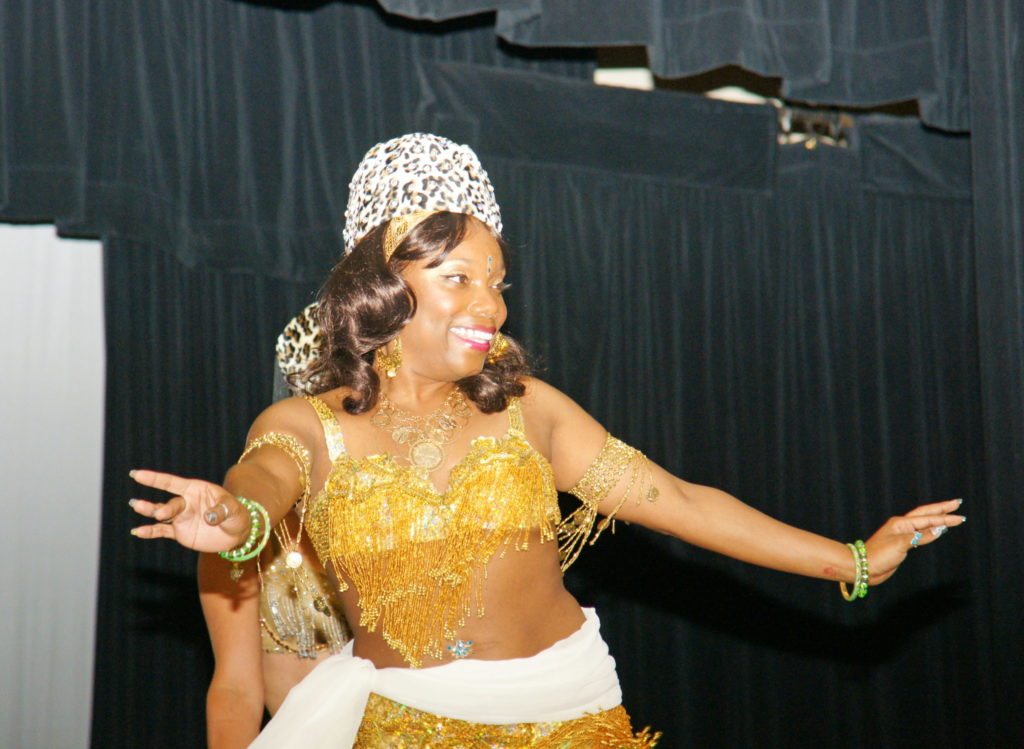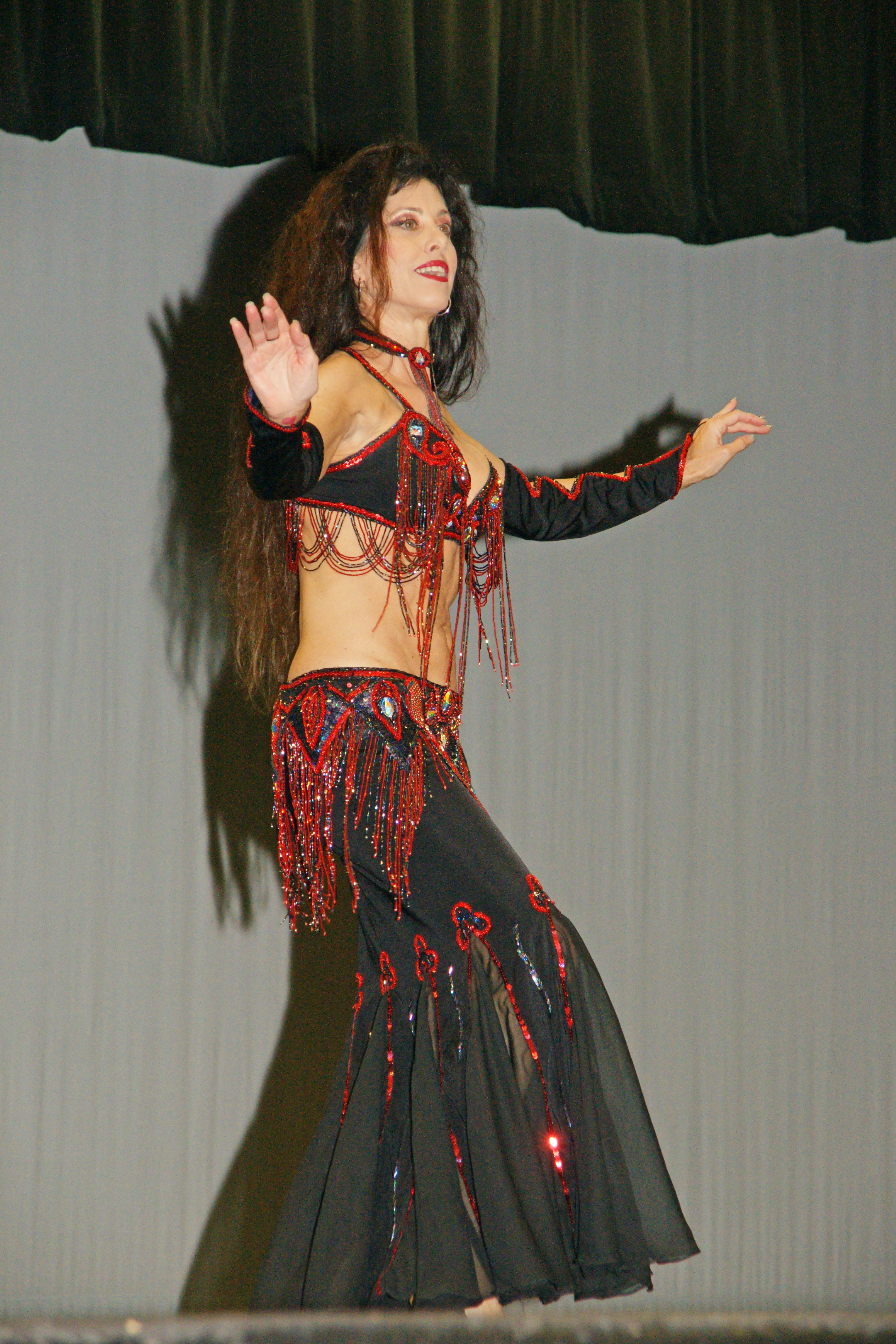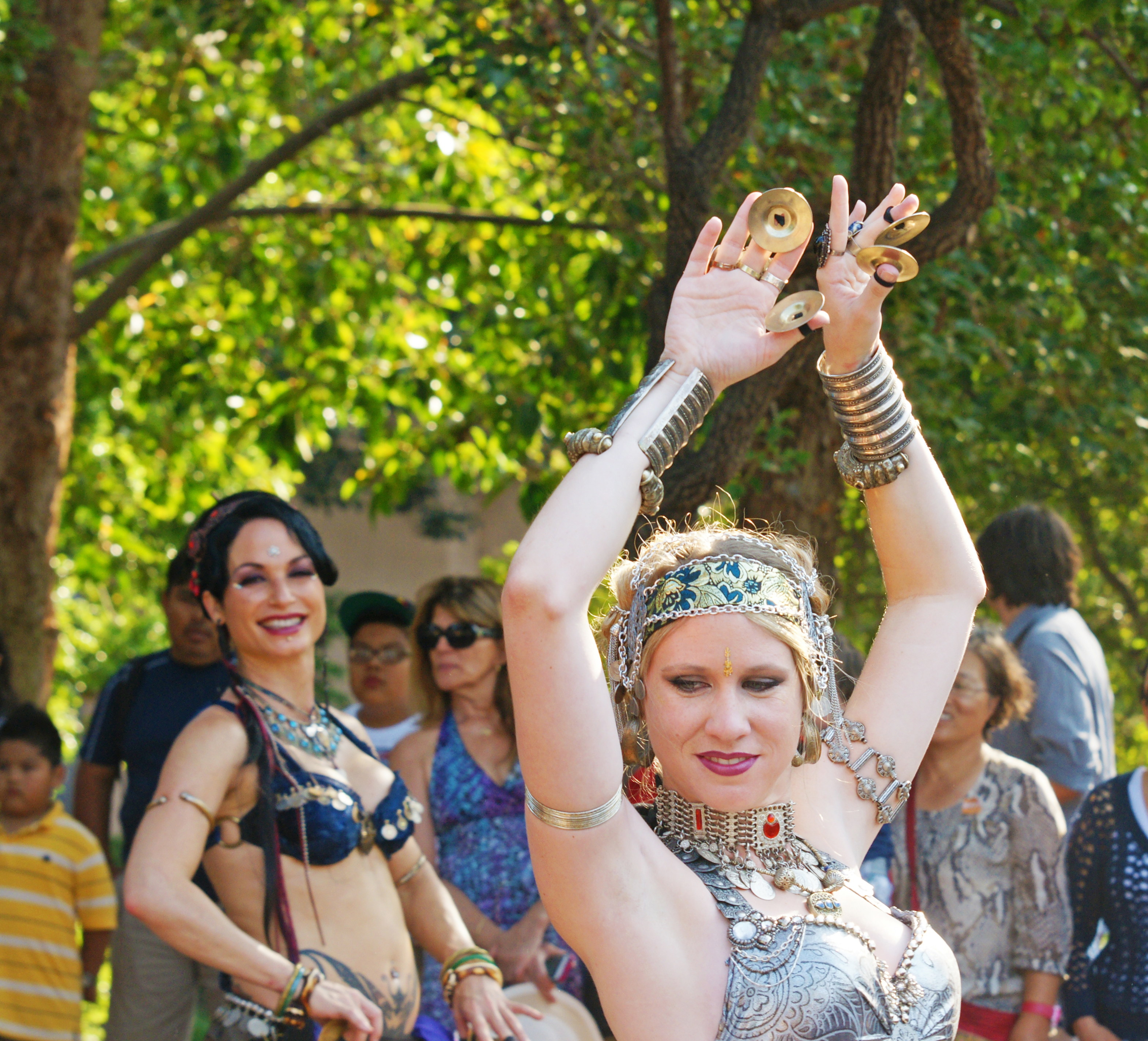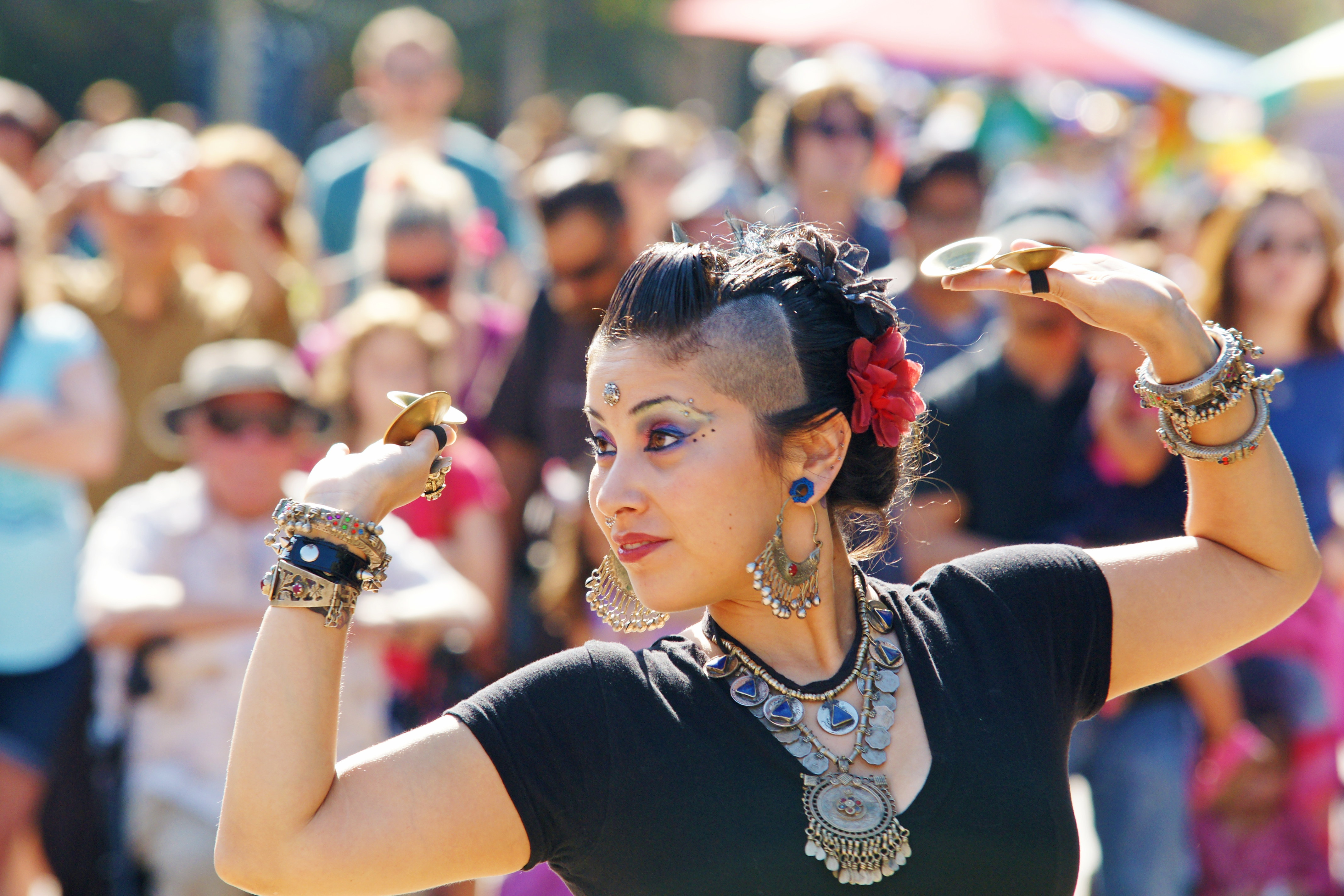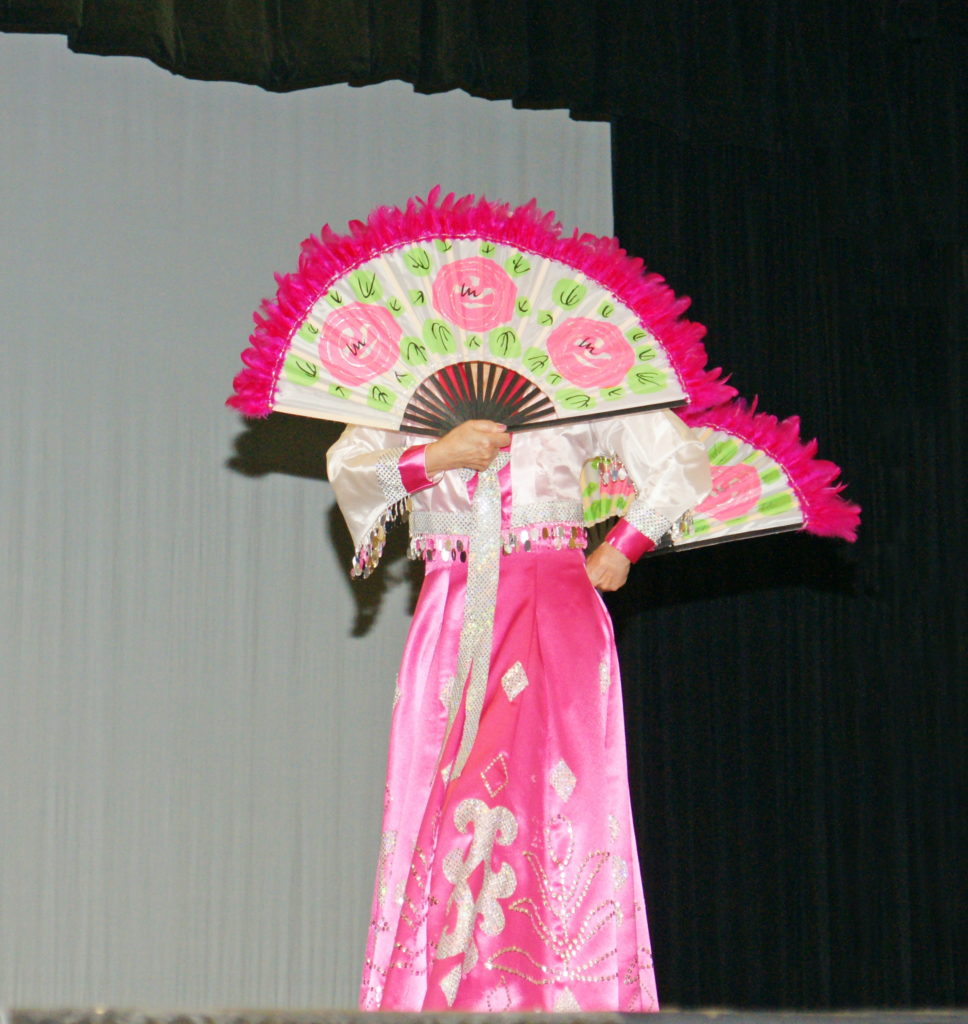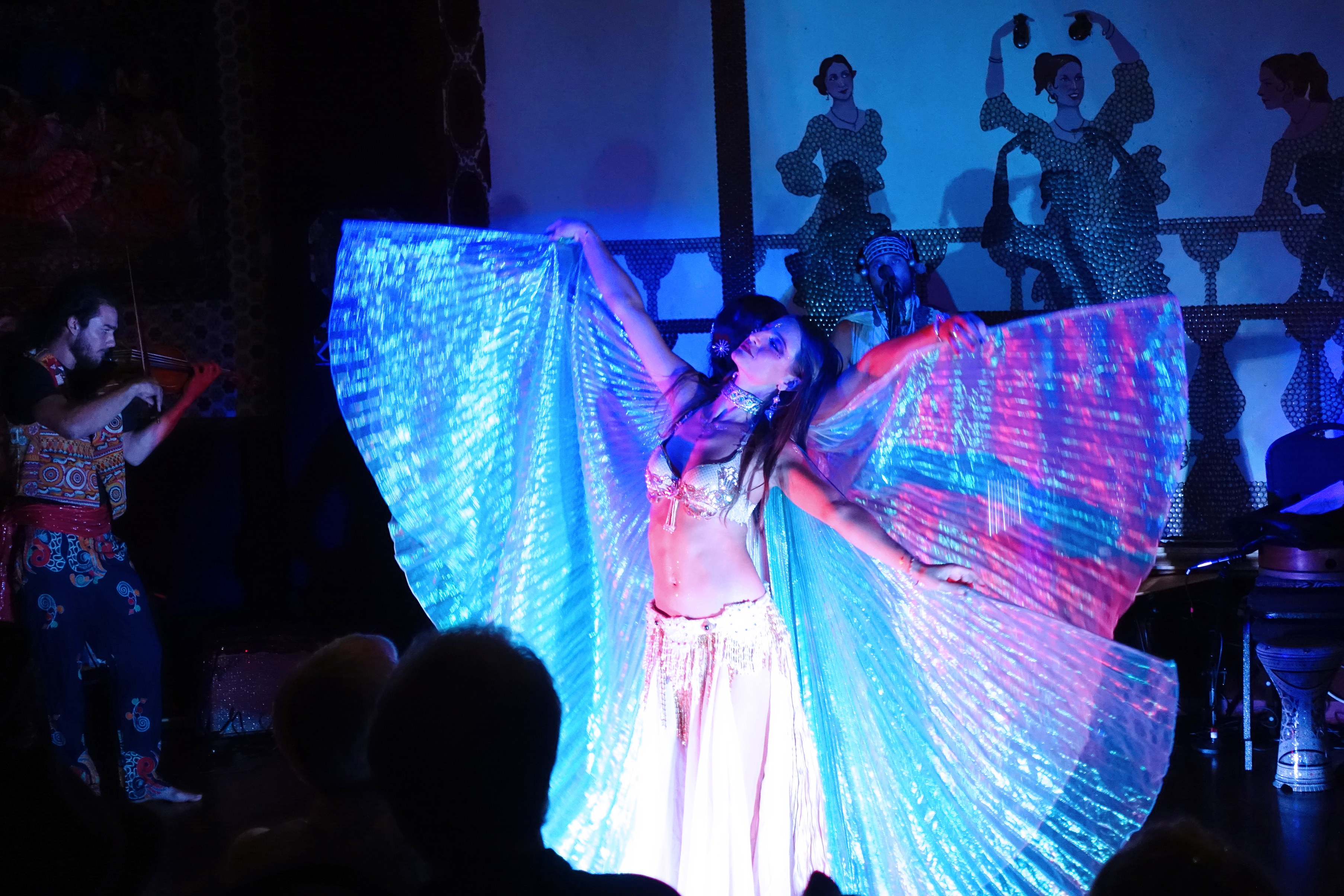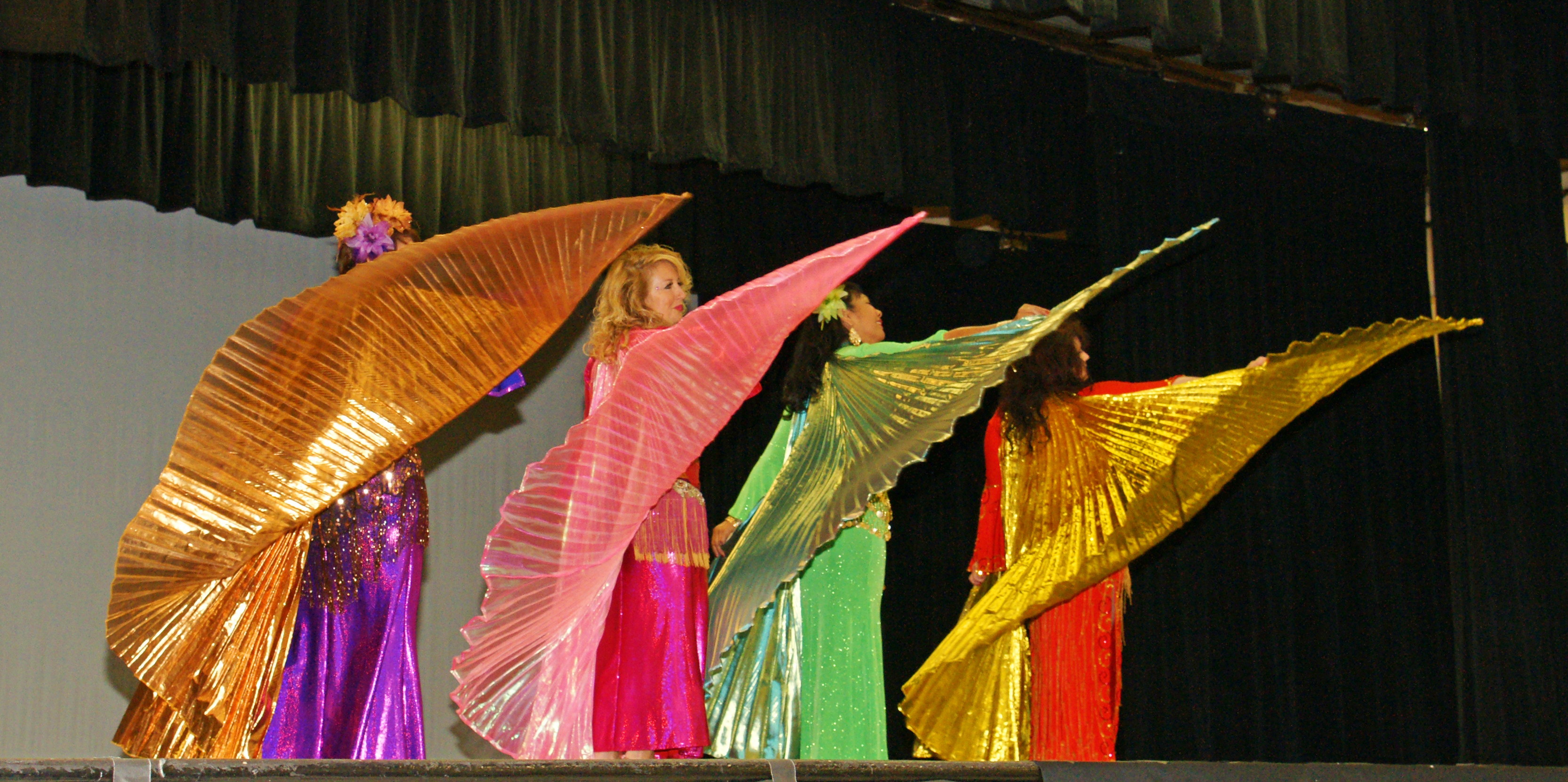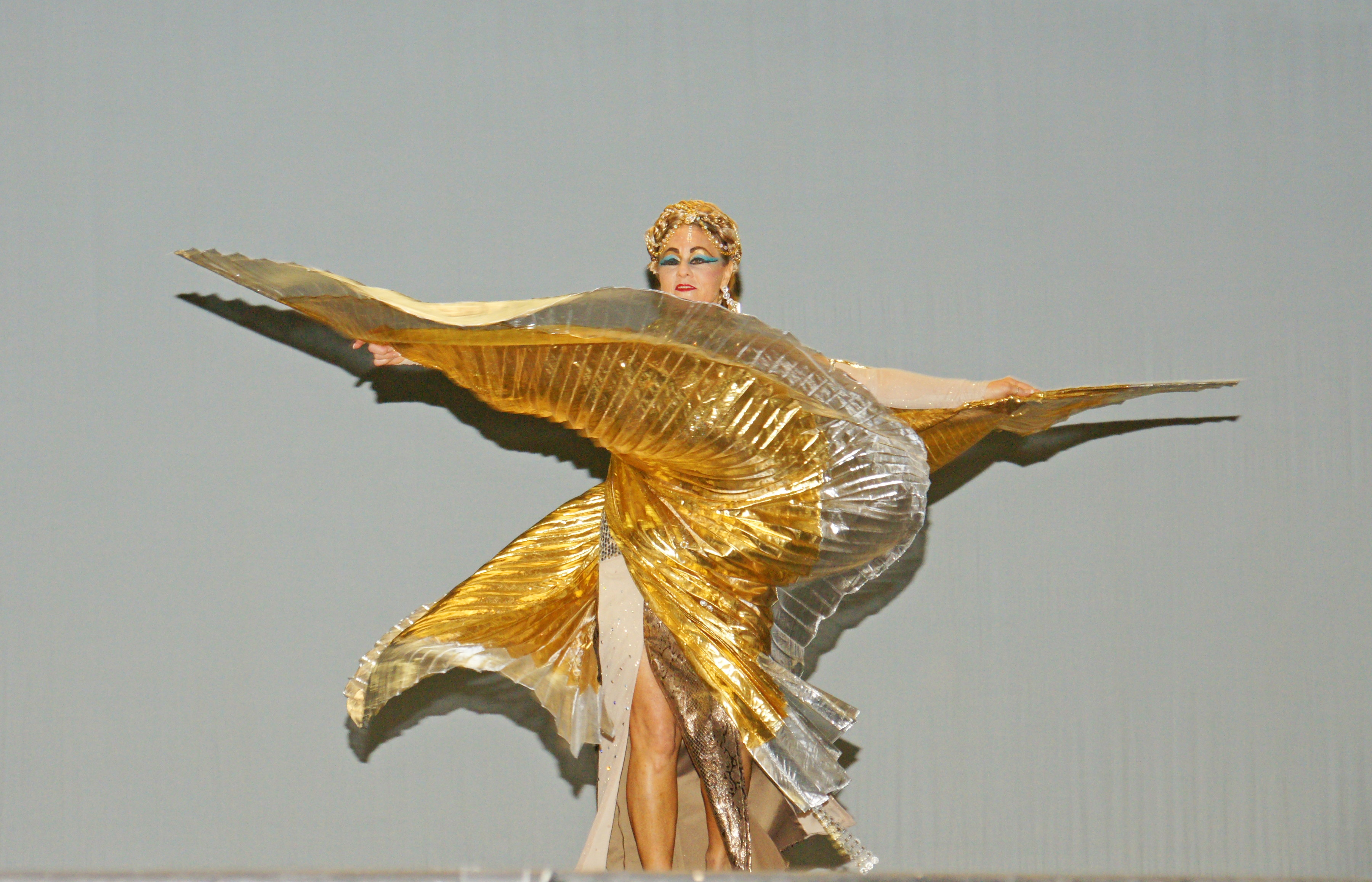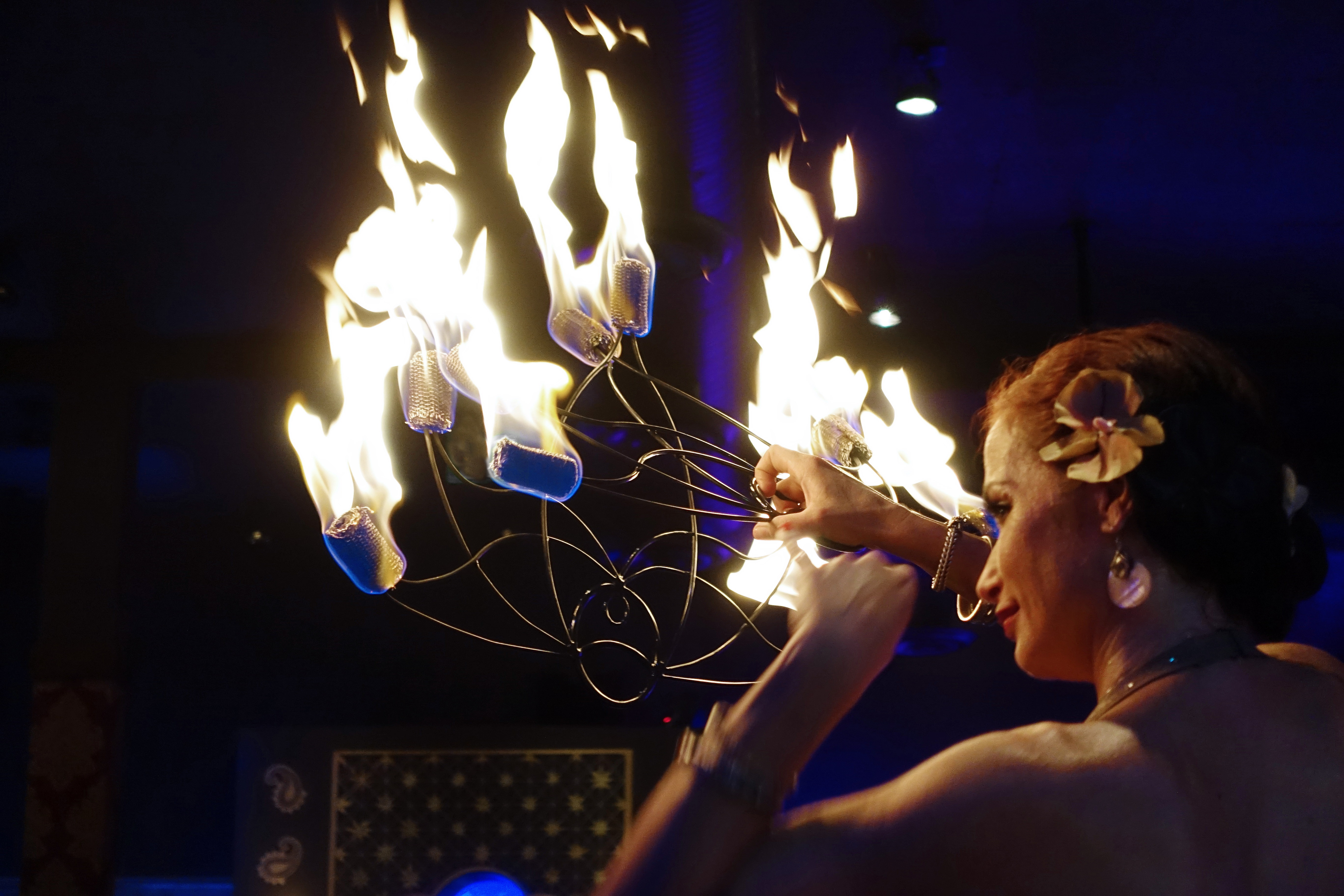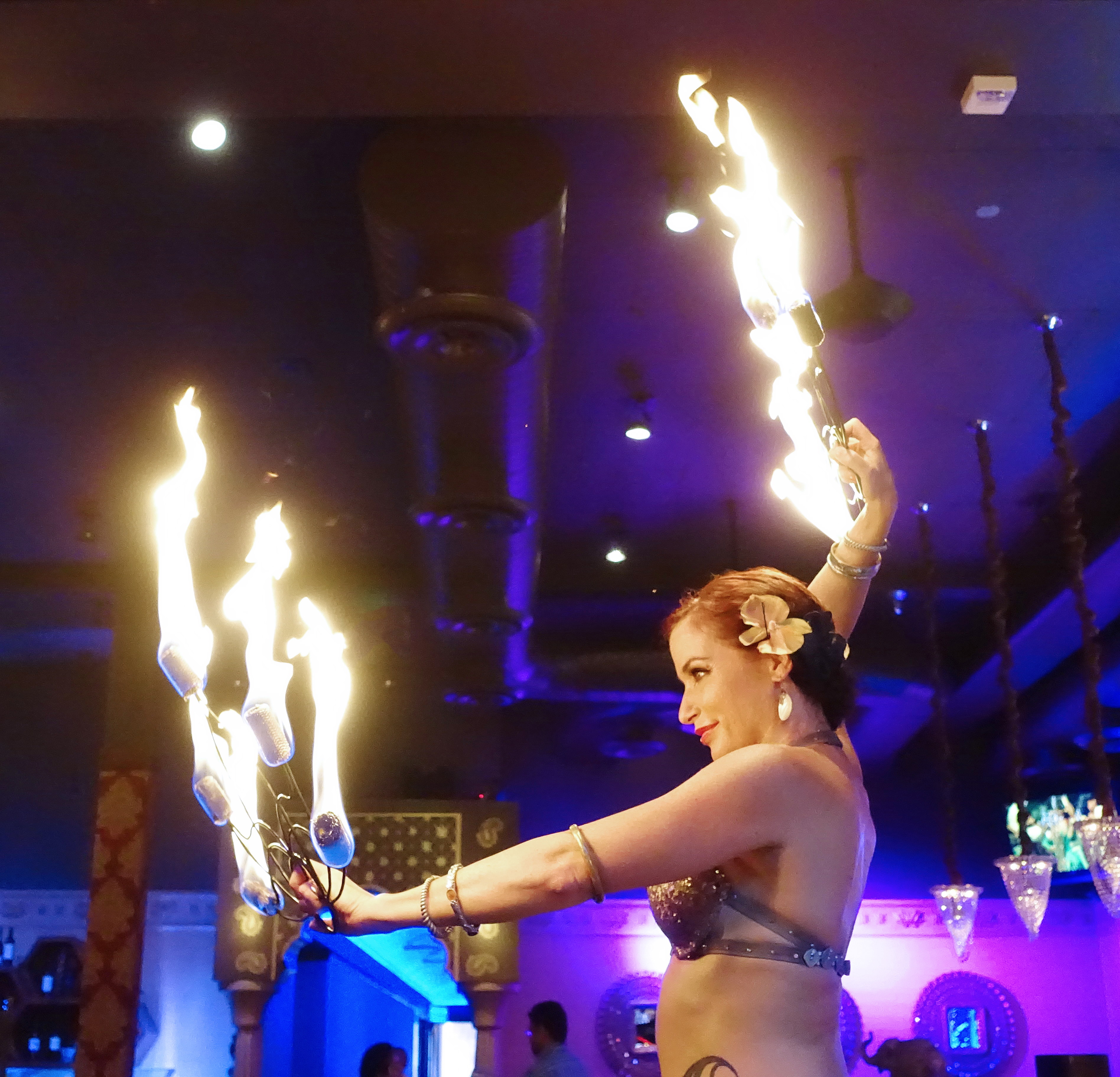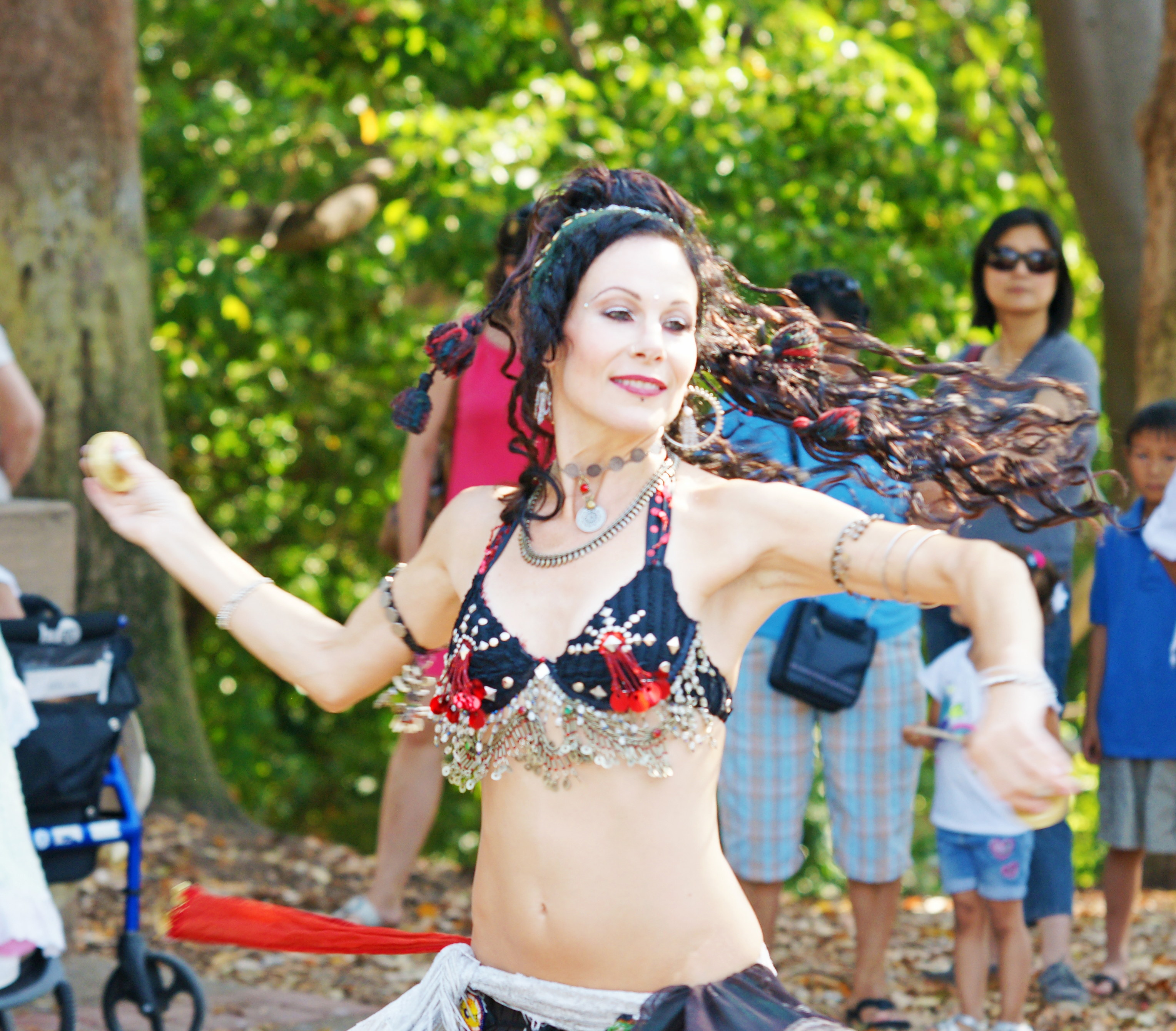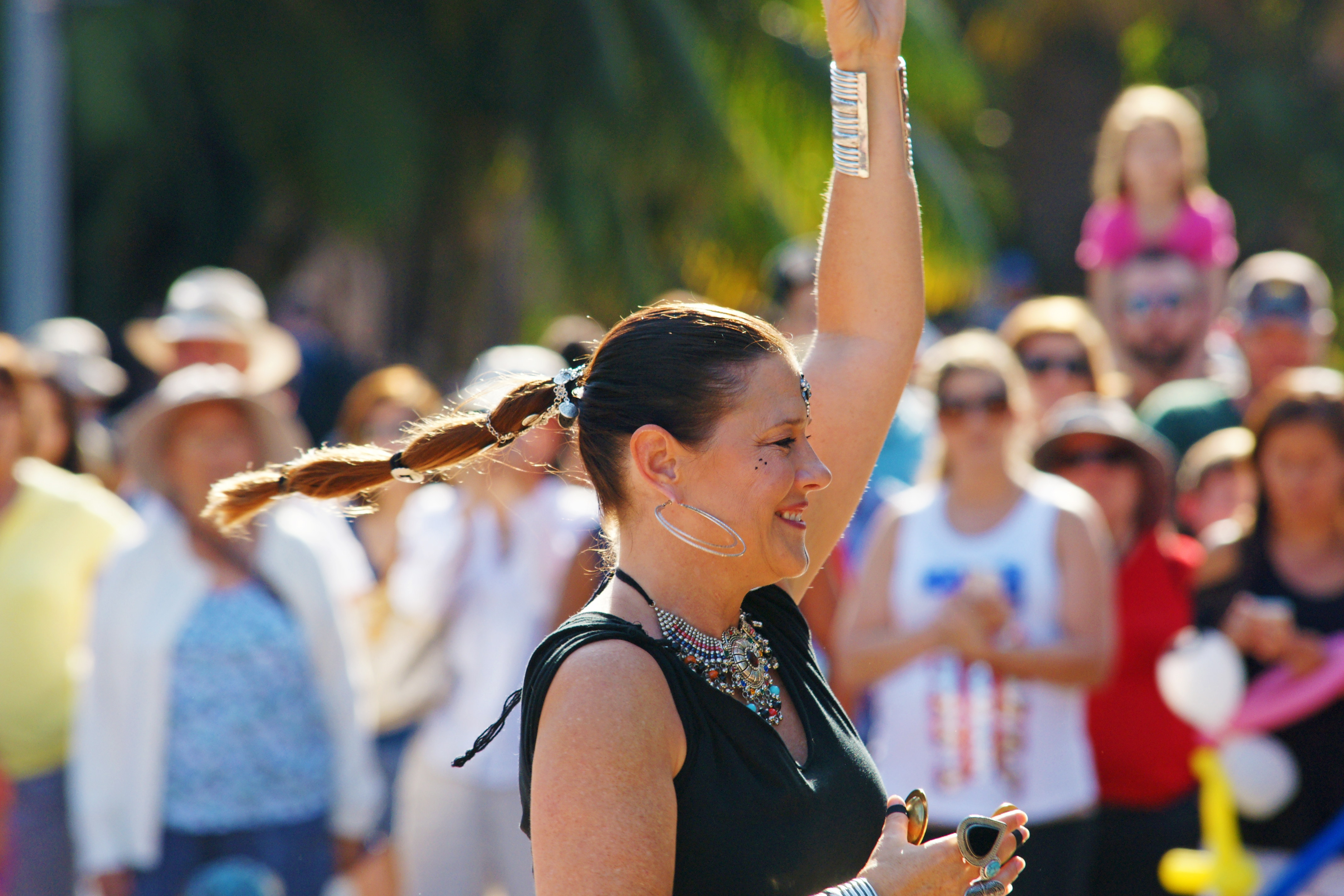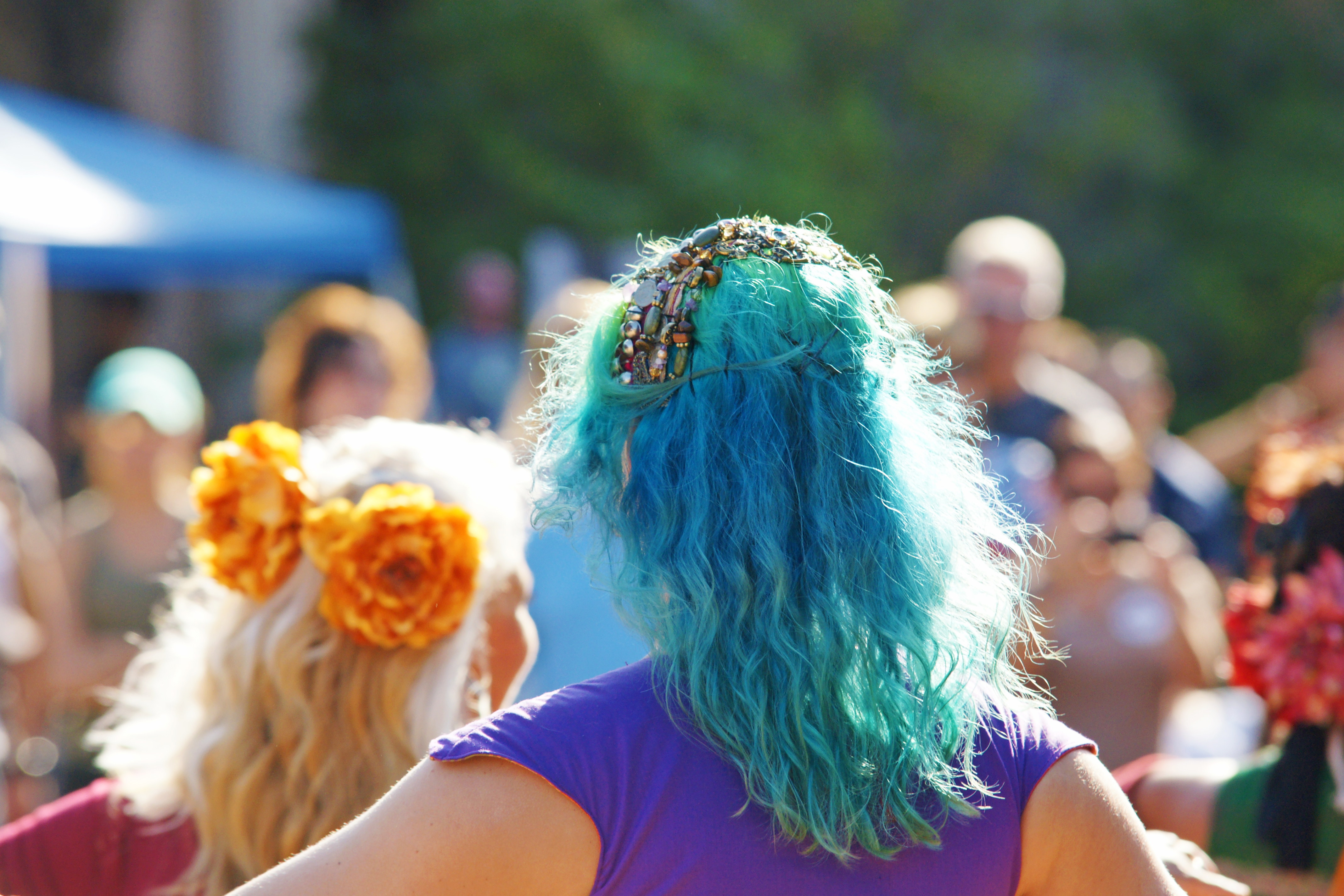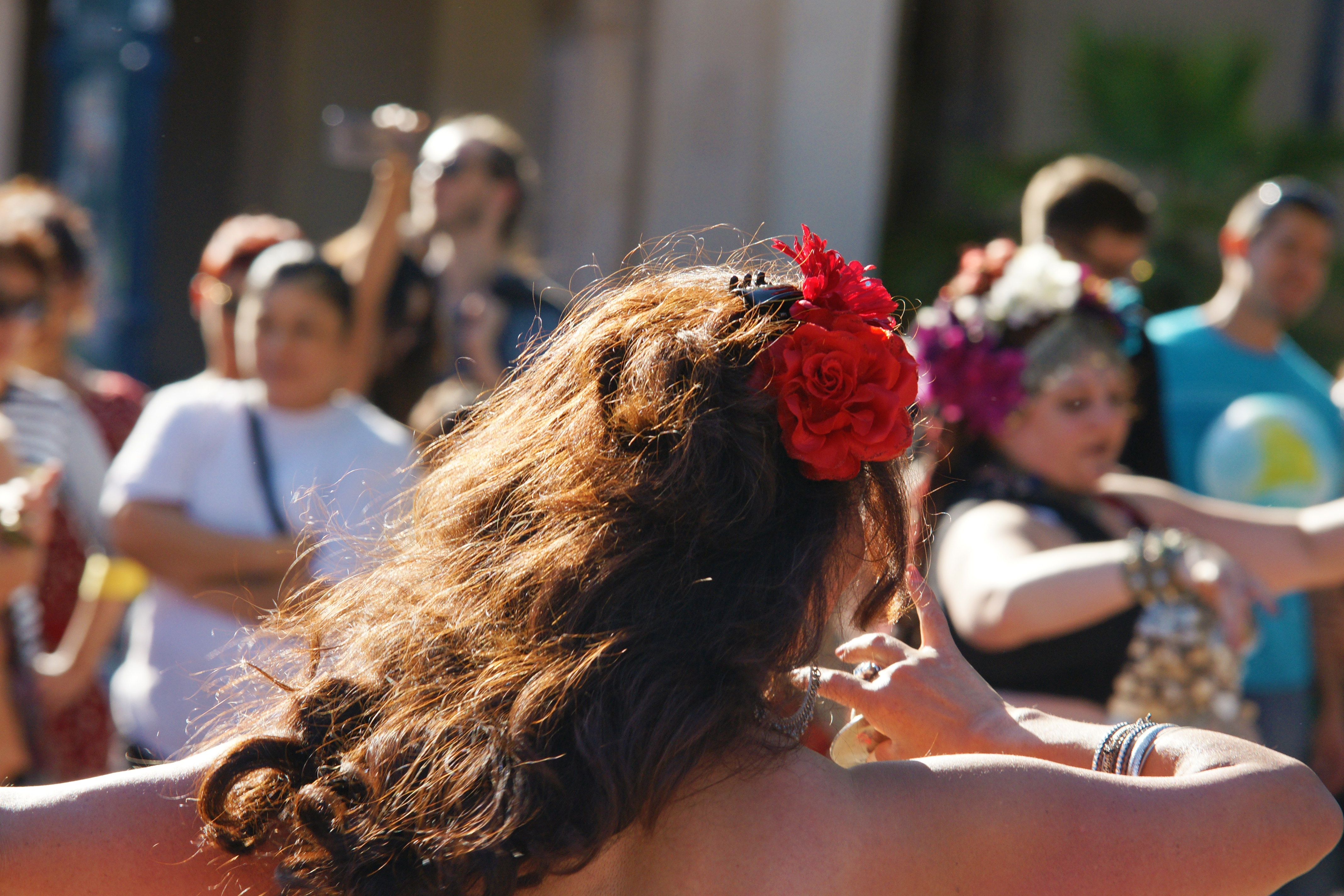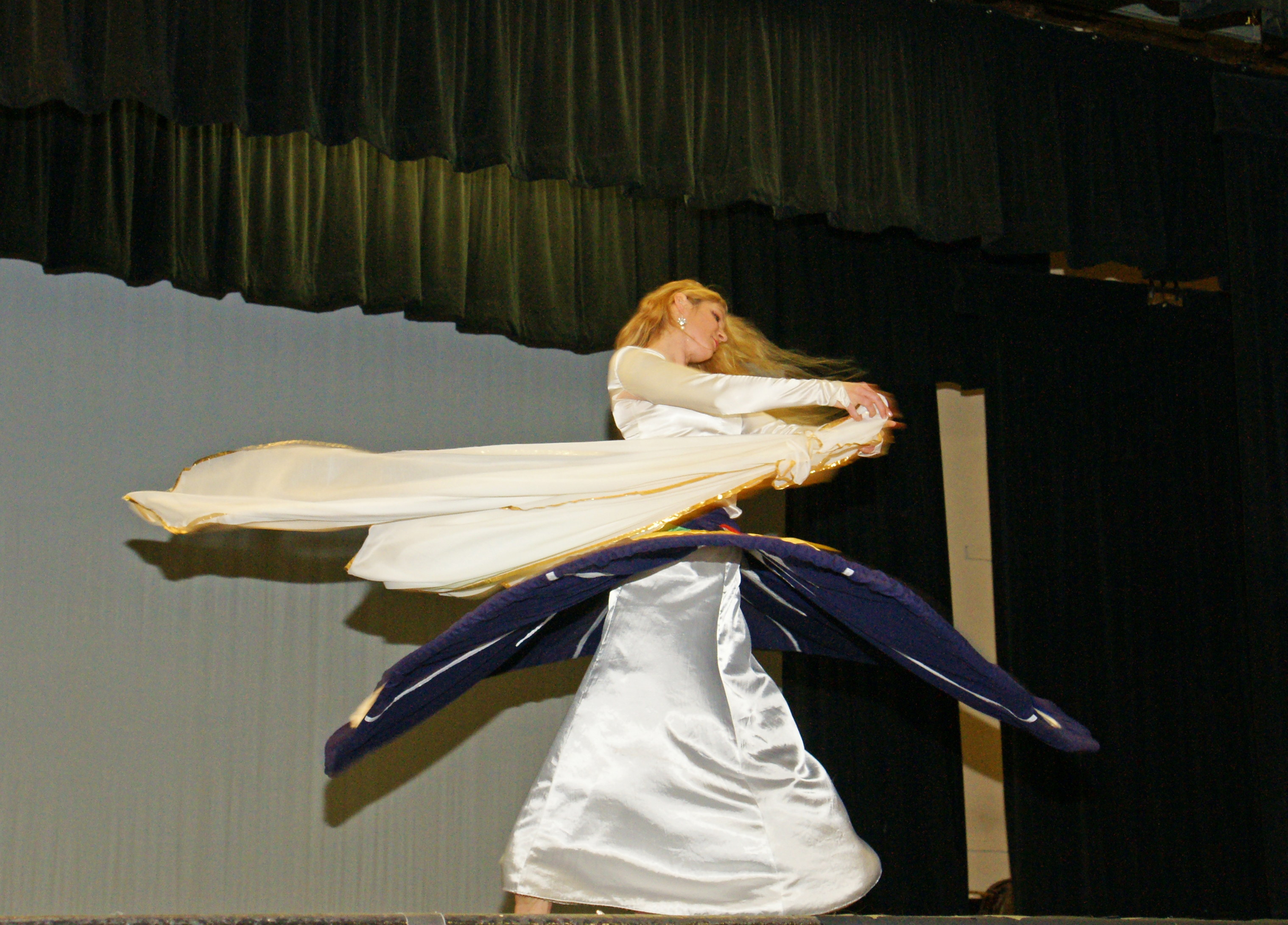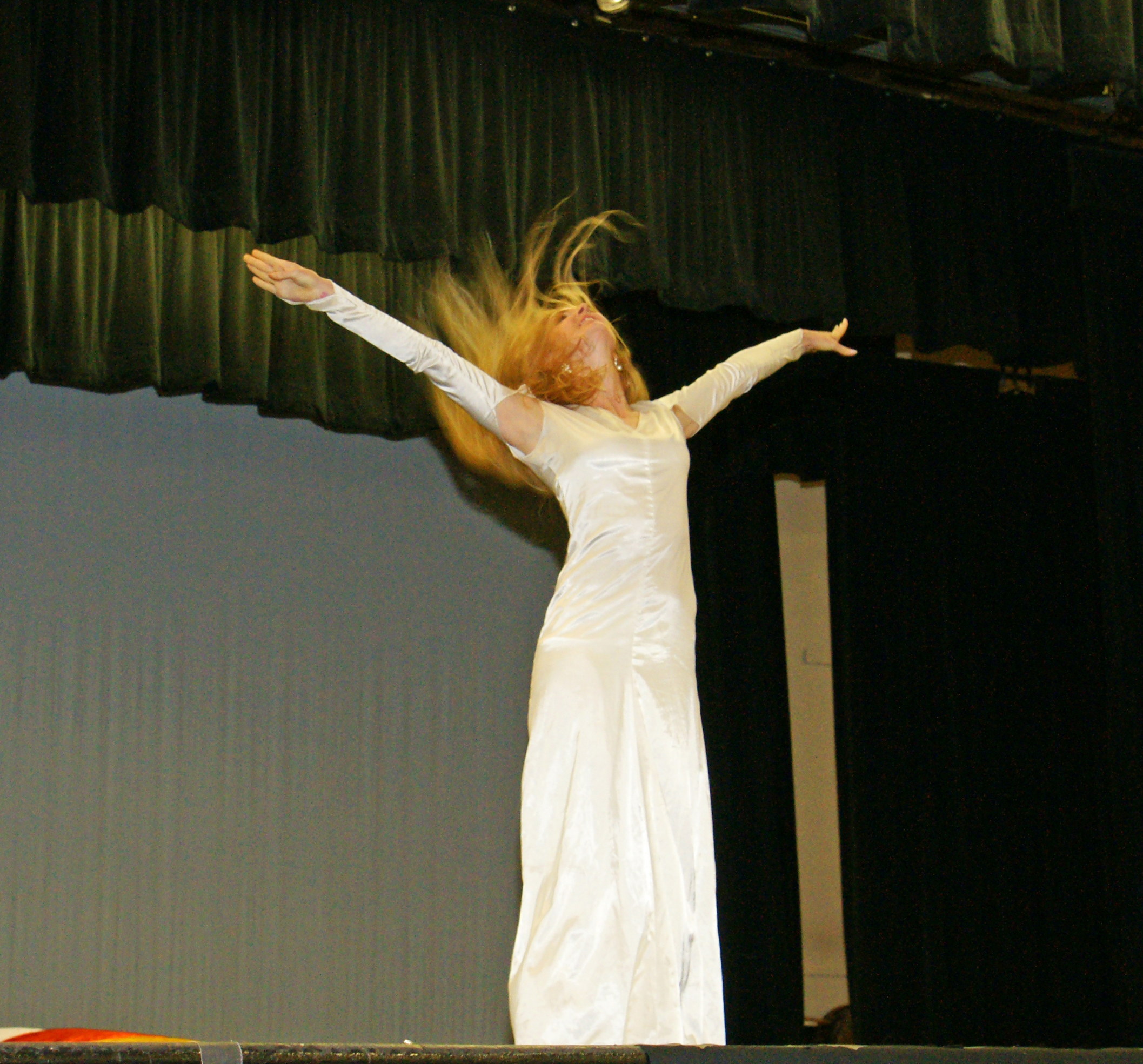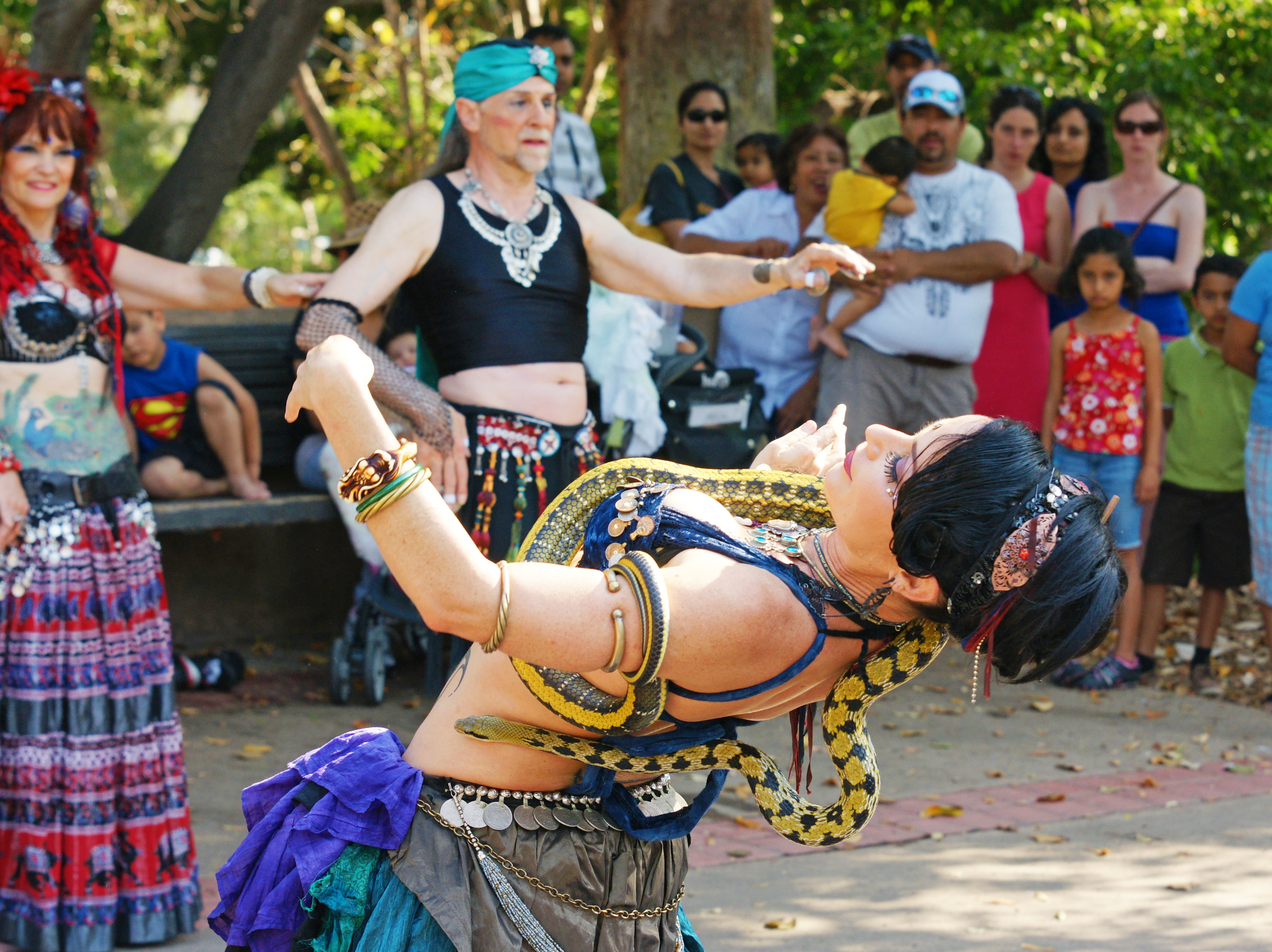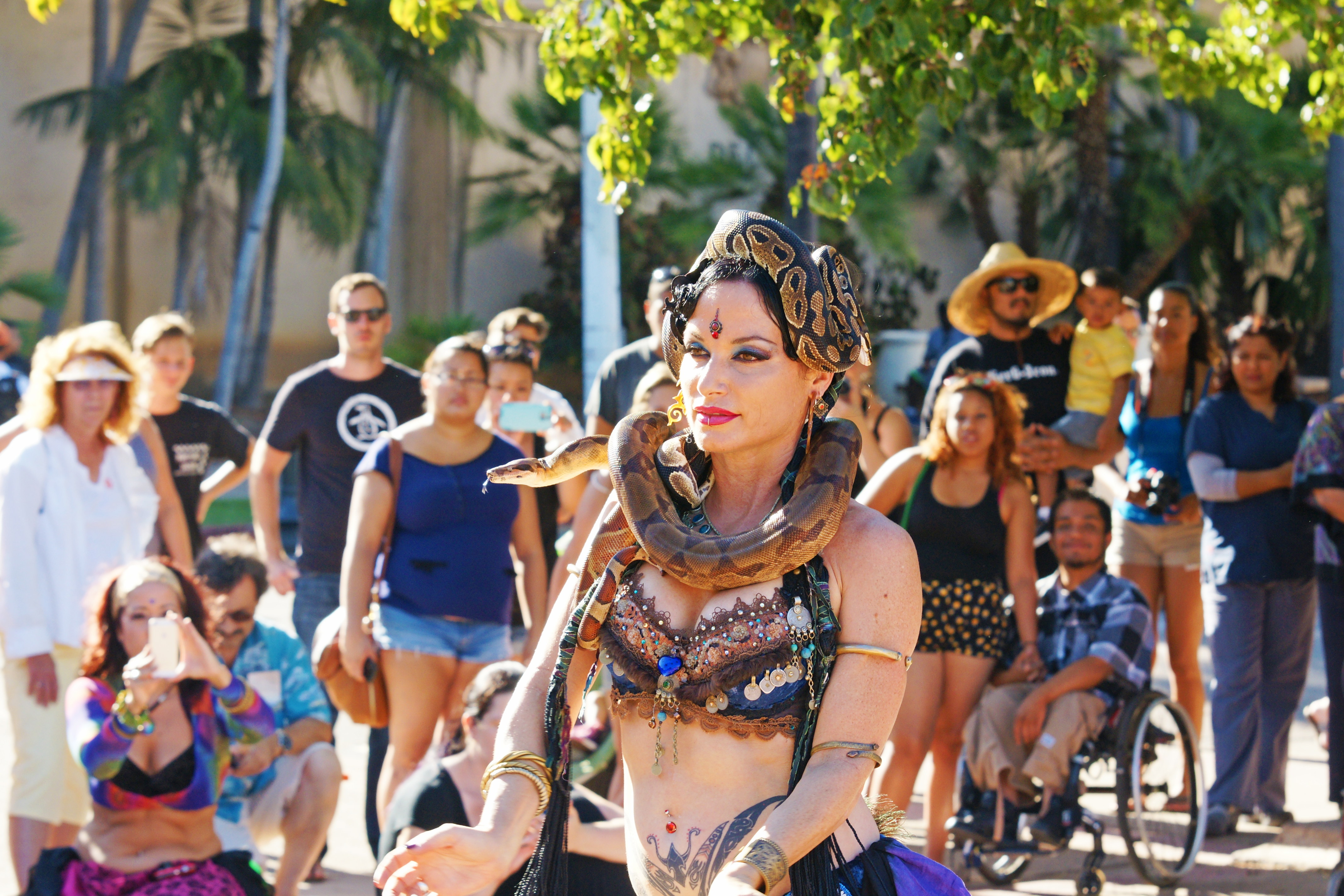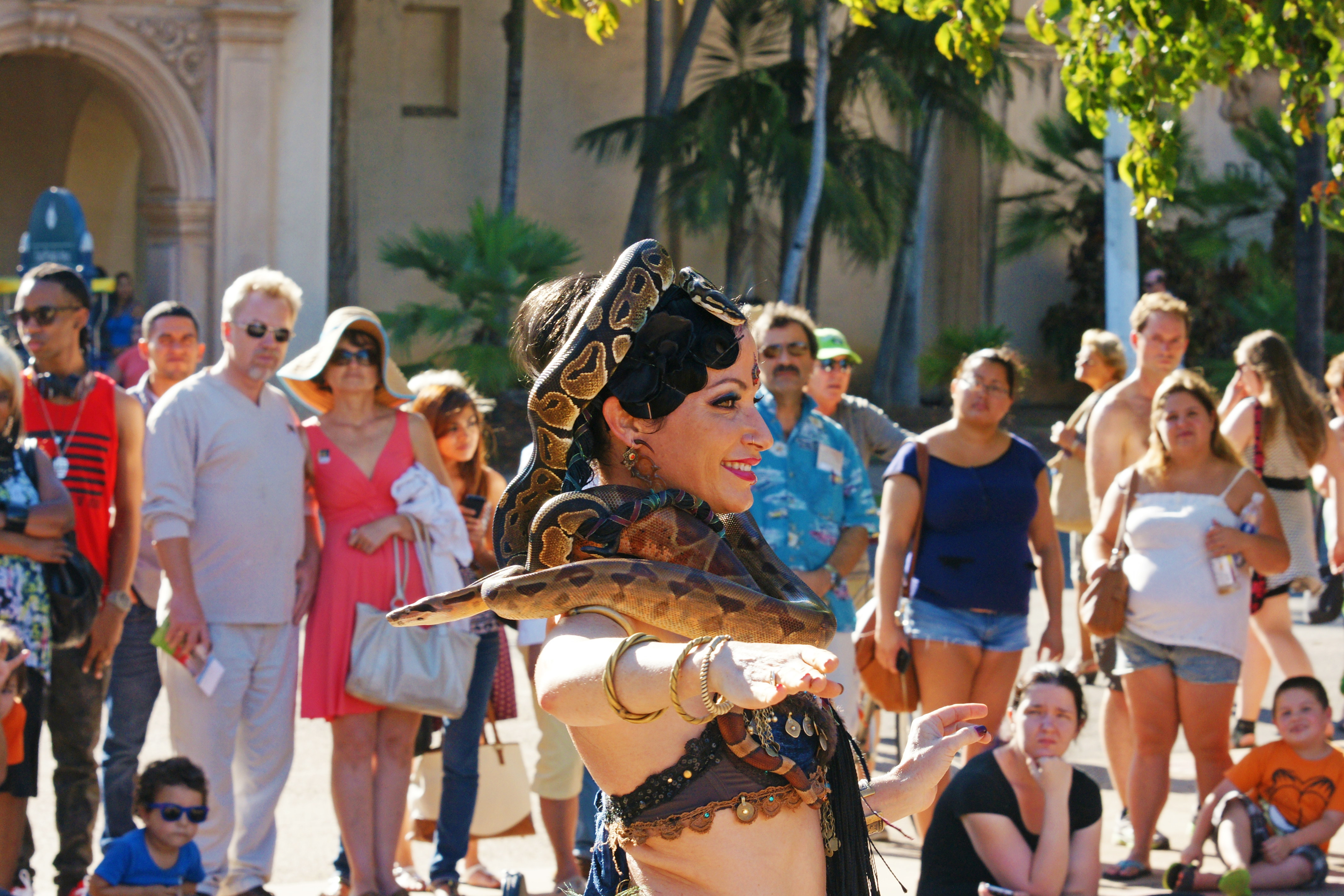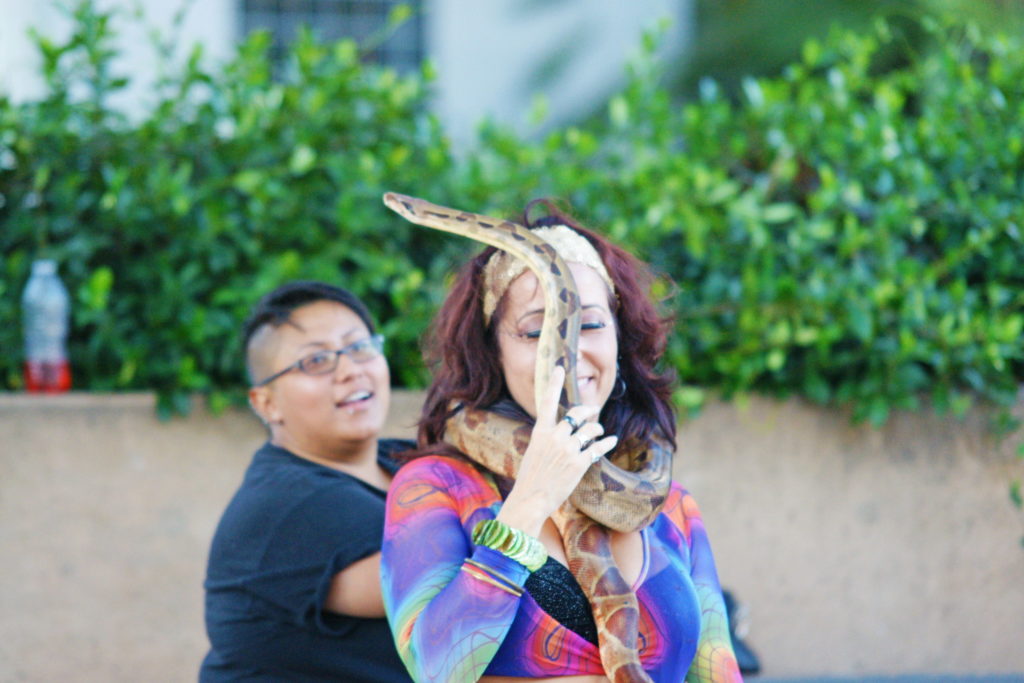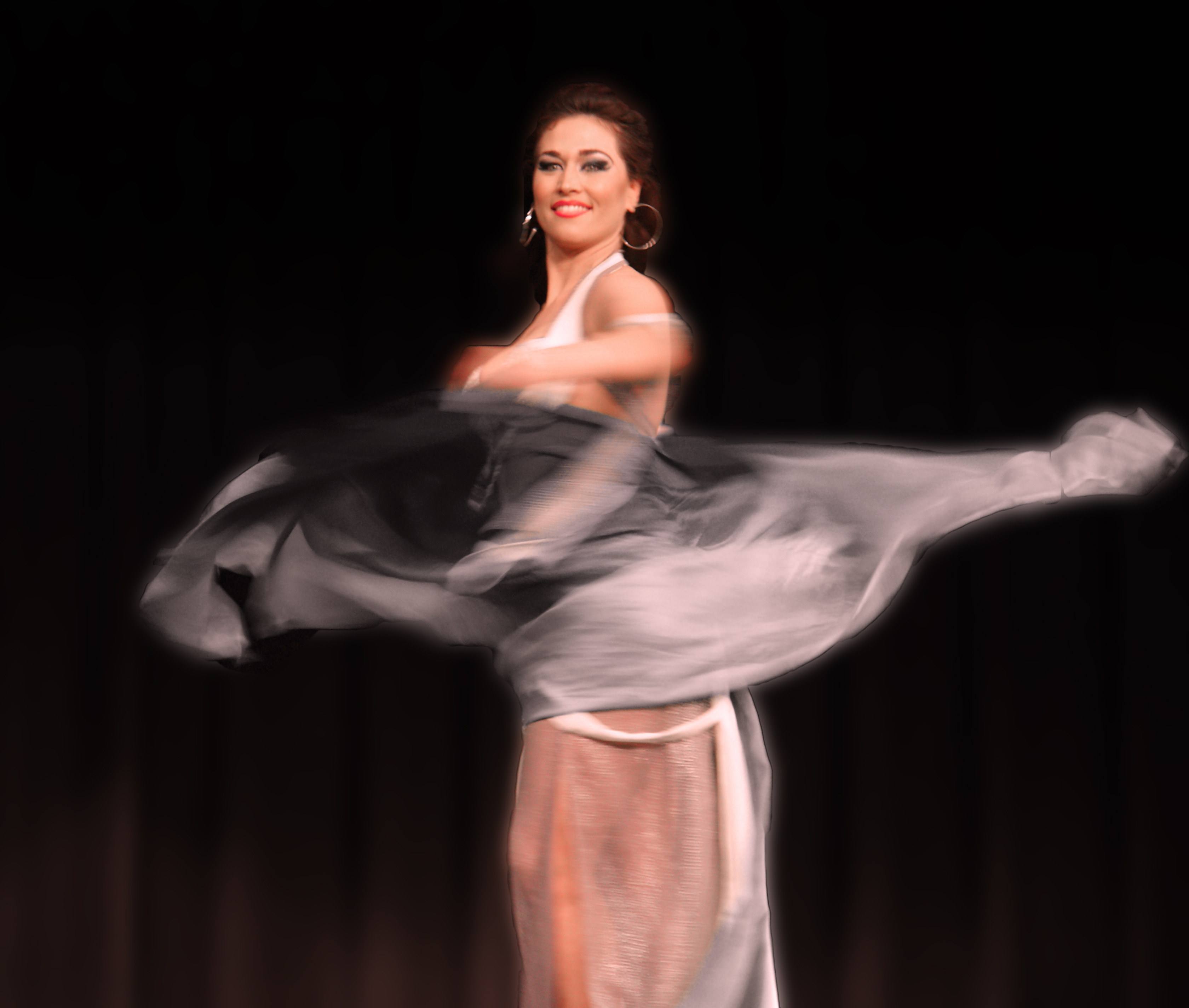“Belly dance” is a translation of the French term danse du ventre, which was coined in 1864 as a nickname for the Orientalist painting The Dance of the Almeh by French artist Jean-Léon Gérôme. Over time, danse du ventre came to be used in French for all solo, torso-articulated dances of Middle Eastern origin. The English translation “belly dance” seems to have made its first appearance in 1889 in reference to the Egyptian dancers who performed at the Exposition Universelle that was held in Paris that year.
Oriental Dancing
The dance itself, also referred to as Raqs Sharqi (Arabic: رقص شرقي, lit. ‘Raqs sharqi’, literally: “oriental dancing”) is an Arabic expressive dance that originated in Egypt and that emphasizes complex movements of the torso. It has evolved to take many different forms depending on the country and region, both in costume and dance style; with Egyptian style and its famous traditional rhymes being the most common worldwide having many schools around the globe practicing it.
When immigrants from Arab states began to arrive in New York in the 1930s, dancers started to perform in nightclubs and restaurants. In the late 1960s and early 1970s many dancers began teaching. Middle Eastern or Eastern bands took dancers with them on tour, which helped spark interest in the dance.
Although using Turkish and Egyptian movements and music, American Cabaret (“AmCab”) belly dancing has developed its own distinctive style, using props and encouraging audience interaction.
The costume most commonly associated with belly dance is the ‘bedlah’ (Arabic: بدلة; literally “suit”) style, which typically includes a fitted top or bra, a fitted hip belt, and a full-length skirt or harem pants. The bra and belt may be richly decorated with beads, sequins, crystals, coins, beaded fringe and embroidery. The belt may be a separate piece, or sewn into a skirt.
In the modern era, professional performers (including dancers, singers, and actors) are not considered to be respectable in more conservative Middle Eastern countries, and there is a strong social stigma attached to female performers in particular, since they display their bodies in public, which is considered haram in Islam. However, in Lebanon, Turkey, Morocco, Iraq and unofficially in Iran and Egypt the art is still celebrated and performed.
American Tribal Style
American Tribal Style (ATS) Belly Dance involves group improvisation. Tribal is generally performed in a group, often at community events such as festivals and parades, with tribal dancers typically favoring a look provided by wide-legged pants gathered at the ankles (also known as pantaloons), tops known as cholis. and full skirts.
American tribal-style belly dance’s movements are inspired by folkloric dances of the Middle East, North Africa, Spain and India. ATS is a method of improvisational choreography, using a vocabulary of movements and cues allowing the dancers to improvise together while dancing. The knowledge of the dance vocabulary allows ATS dancers from different regions to collaborate even if they have not previously danced with each other.
American Tribal Style belly dancers always use finger cymbals or zils, but the focus is on the group as opposed to emphasizing solo performance. There are two families of movements: slow movements and fast movements. Zils are worn but not usually played while performing “slow movements”. (However, for example, if the featured duet trio or quartet are dancing to a Moroccan 6 rhythm, members of the chorus may choose to accompany them through playing their zils.) During “fast movements”, the zils are meant to be played. The most common rhythm played on the dancer’s zils is the right-left-right pattern. Certain “fast” movements require the dancers and chorus to play the military zil pattern. Other, less frequently played patterns include the Moroccan 6; some troupes experiment with 9/8 Turkish rhythm.
ATS features call-and-answer performance with other dancers or as a whole group as well as, more uncommonly, solos. Often there is a chorus that provides a moving back-drop while the featured duet, trio, or quartet is the focal point. Dancers take turns coming out of the chorus in duets, trios and quartets.
The style of ATS is also characterized by costumes derived from various “folkloric” traditions and cultures and is often composed of one or more long, full, tiered (usually 25-yard) skirts over full pantaloons; a short choli top that bares the midriff, over which a bra decorated with coins and textiles is worn; a decorative headband, turban, and/or hair flowers and other decorations; one or more hip scarves with yarn, tassels, or fringe; a decorative belt, often with tassels, coins, and/or medallions; and much oxidized silver jewelry. The jewelry commonly originates from Central Asia, from any number of nomadic tribes or empires (e.g., Kuchi, Turkoman, Rajasthan), and is often large and set with semi-precious stones or, when mass-produced, glass. Makeup usually focuses on a dark eye and red lip, and a decorative bindi is often worn. Some dancers “tattoo” their faces with kohl. Dancers may perform barefoot or may wear dance shoes or sandals.
The cues and formations are the secret behind group improvisational dance. They allow the dancers to move together without choreography. Sometimes, troupes will create formal choreography while still using the ATS-specific formations and cues.
When dancing in bright sunlight, modifications to ATS costuming is required.
Performances
Although belly dance can be interpretive or free-form, some artists engage in choreographed expressions.
According to the internet, the characteristics of an ideal performance state are as follows:
Absence of fear;
Not thinking about the performance;
Adaptive focus on the activity;
A sense of effortlessness and belief in confidence or self-efficacy;
A sense of personal control;
A distortion of time and space where time does not affect the activity.
In addition, the performers must engage the audience’s attention. Good eyeliner is your friend.
At the end of a performance, it is common to freeze when the music finishes, giving the audience the opportunity to express their gratitude by percussively striking their hands together.
Musicians
According to the internet, “a musician is a person who plays a musical instrument.” Now that we have that cleared-up…
Drummers frequently play drums when drumming for belly dancers. For many dancers, the simple percussion is easy to translate into movement.
The violin, sometimes known as a fiddle, is a wooden chordophone in the violin family. The music from this instrument provides dancers the opportunity to explore softer movements.
The didgeridoo is played with continuously vibrating lips to produce the drone while using circular breathing. This technique requires breathing in through the nose whilst simultaneously expelling stored air out of the mouth using the tongue and cheeks. By use of this technique, a skilled player can replenish the air in their lungs, and with practice can sustain a note for as long as desired. Recordings exist of modern didgeridoo players playing continuously for more than 40 minutes; Mark Atkins on Didgeridoo Concerto (1994) plays for over 50 minutes continuously. The didgeridoo functions “…as an aural kaleidoscope of timbres” and “the extremely difficult virtuoso techniques developed by expert performers find no parallel elsewhere.”
Musicians focus on the dancers, ensuring the music is within the dancer’s repertoire and to be aware of when the dancer wishes to finish the dance. At least, good musicians do. ?
Veils
A veil is an article of clothing or hanging cloth that is intended to cover some part of the head or face, or an object of some significance. Veiling has a long history in European, Asian, and African societies. The practice has been prominent in different forms in Judaism, Christianity, and Islam. The practice of veiling is especially associated with women and sacred objects, though in some cultures it is men rather than women who are expected to wear a veil. Besides its enduring religious significance, veiling continues to play a role in some modern secular contexts, such as wedding customs.
However, that has nothing to do with veils in belly dancing.
Veils are used to add flow and motion to the dancer’s performance.
Veils highlight the dancer, both in form and in color.
On a big stage, veils can help the dancers fill the space with added motion and colors.
Most dancers do not use veils when performing outdoors, because pulling out their veils seems to trigger gusts of wind designed to foil their intent.
Fans
A handheld fan is any broad, flat surface that is waved back-and-forth to create an airflow. On human skin, the airflow from handfans increases evaporation which has a cooling effect due to the latent heat of evaporation of water. It also increases heat convection by displacing the warmer air produced by body heat that surrounds the skin, which has an additional cooling effect, provided that the ambient air temperature is lower than the skin temperature – which is typically about 33 °C (91 °F).
But that’s not important here.
As with veils (see above), fans are used to add flow and motion to the dancer’s performance.
Dancers who are shy, or perhaps have an oriental style, can use the fans to draw attention to their face, or lack thereof.
Wings of Isis
As you are aware, Isis is one of the main characters of the Osiris myth, in which she resurrects her slain husband, the divine king Osiris, and produces and protects his heir, Horus. Isis and Nephthys often appear together, particularly when mourning Osiris’s death, supporting him on his throne, or protecting the sarcophagi of the dead. In these situations, their arms are often flung across their faces, in a gesture of mourning, or outstretched around Osiris or the deceased as a sign of their protective role. In these circumstances, they were often depicted as kites or women with the wings of kites. This form may be inspired by a similarity between the kites’ calls and the cries of wailing women, or by a metaphor likening the kite’s search for carrion to the goddesses’ search for their dead brother. Isis sometimes appeared in other animal forms: as a sow, representing her maternal character; as a cow, particularly when linked with Apis; or as a scorpion. She also took the form of a tree or a woman emerging from a tree, sometimes offering food and water to deceased souls. This form alluded to the maternal nourishment she provided.
Therefore, it is only natural that belly dancers honor Isis and her wings.
The Wings of Isis are like a superfan or superveil, adding superflow and supermotion to the dancer’s performance.
In the hands of an artist, the Wings of Isis can transform the dancer into any number of insects.
The dancer spins and, in spinning, conceals herself. Will she be able to un-spin? We must wait to find out!
Performance art adds majesty to an otherwise morbid Egyptian myth.
As a cautionary note, the “Wings of Isis” have nothing to do with the militant Islamist group sometimes abbreviated ISIS.
Fire
The Titan god of fire, Prometheus, is credited with the creation of humanity from clay, and later defies the gods by stealing fire and giving it to humanity as civilization. Thus, since belly dancers are civilized (and possibly made from clay—who can say?), it is natural for them to incorporate this gift into their performance.
As you know, fire is the rapid oxidation of a material in the exothermic chemical process of combustion, releasing heat, light, and various reaction products. Fire is hot because the conversion of the weak double bond in molecular oxygen, O2, to the stronger bonds in the combustion products carbon dioxide and water releases energy (418 kJ per 32 g of O2); the bond energies of the fuel play only a minor role here. At a certain point in the combustion reaction, called the ignition point, flames are produced.
So, naturally, pretty girls want to dance with it.
Given the potential for a conflagration engulfing the restaurant and all those in attendance, the crowd watches the belly dancer, afraid to look away. Notice, too, that the belly dancer has a British pound protruding from her belt; obviously, she is in Britain, possibly even Great Britain, where laws concerning fire and enclosed, burnable spaces differ.
The belly dancer reveals the ancient art of Fire Hair Removal. Unfortunately, she stops well before giving herself a Brazilian.
Fire is one of the four classical elements in ancient Greek philosophy and science. It was commonly associated with the qualities of energy, assertiveness, and passion.
Hair
Hair, the protein filament that grows from follicles found in the dermis, is one of the defining characteristics of mammals. Belly dancers do not need hair to dance, and, in fact, frequently remove their hair while dancing (see above). However, when they have a profusion growing from their scalp, they sometimes incorporate it into their dance.
If a dancer’s hair is substantial, it can be used to counterbalance the dancer during chest-lifts.
Hairy dancers rotate their upper torso while flinging their head about, allowing their hair to add to the flow and motion (see Veils, Fans, and Wings of Isis above) of the dance.
Hair color can be a costume choice, adding color to an already colorfully-costumed dancer.
According to the internet, “Attitudes towards different forms of hair, such as hairstyles and hair removal, vary widely across different cultures and historical periods, but it is often used to indicate a person’s personal beliefs or social position, such as their age, sex, or religion.”
Bending
Dancers bend, and especially belly dancers bend. They really, really like to bend backwards.
But, not really. The secret is to NOT bend your back, but rather to extend and stretch your front AND your back. Back injury is avoided, and the dancer has better control of balance.
Some dancers choose to not tilt their head all the way back, but to keep the head and neck muscles engaged. This also avoids a sometimes-spooky upside-down face.
Stretching and extending stomach muscles allows the dancers to maintain core strength while bending backwards.
As a further example, the core muscles are engaged yet the back muscles themselves are not scrunched.
Dancers bend in many ways that non-dancers do not. And they make it look good. ?
Swords
A sword is a bladed melee weapon intended for cutting or thrusting that is longer than a knife or dagger, consisting of a long blade attached to a hilt. The blade can be straight or curved. Thrusting swords have a pointed tip on the blade, and tend to be straighter; slashing swords have a sharpened cutting edge on one or both sides of the blade, and are more likely to be curved. Many swords are designed for both thrusting and slashing.
Quite naturally, belly dancers incorporate swords into their dancing.
Notice that this is not a stabbing sword, but a slashing sword, closely related to the Ottoman kilij. Thus, one edge is sharp and one is not. The secret is knowing which is which.
The scimitar is positioned carefully on the dancer’s head. She shows her distain for the obvious danger by placing her fingers lightly on the blade’s edge.
As in ancient times, having a background in ballet affords the dancer a certain poise that can be used for transporting all sorts of objects atop one’s head.
This dancer’s head is adorned with what seems to be a talwar, modified with a hand guard. However, it might be a sabre.
These dancers have taken a common household slashing weapon and attached a flammable component. Should the fire-sword fall from their heads, the wound from the cut would be immediately cauterized!
A bat’leth, commonly used to slay both foes of the Klingon empire and challengers to the Klingon throne, is the sword of choice for manly men.
Whirling Dervish
The Mevlevi Order or Mawlawiyya (Turkish: Mevlevilik or Mevleviyye; Persian: طریقت مولویه) is a Sufi order that originated in Konya (modern-day Turkey; formerly capital of the Anatolian Seljuk Sultanate) and which was founded by the followers of Jalaluddin Muhammad Balkhi Rumi, a 13th-century Persian poet, Sufi mystic, and Islamic theologian. The Mevlevis are also known as the “whirling dervishes” due to their famous practice of whirling as a form of dhikr (remembrance of God). Dervish is a common term for an initiate of the Sufi path; whirling is part of the formal sema ceremony and the participants are properly known as semazens.
But you probably knew that.
When dancers spin, pirouette, or even turn quickly, they must spot or risk dizziness, loss of balance, or, in some cases, emesis. Spotting is even more essential when your entire dance consisted to spinning.
In Egypt, the practice of whirling has been adapted as tanoura (Arabic: التنورة el-tanoura). The word tanoura or tannoura refers to the colorful skirt worn by the whirler, with a color representing each Sufi order.
As the dervish spins, her tanoura slowly rises, eventually leaving her body entirely.
I wonder if she puts in on this way, but in reverse…
Snakes
Snakes and dancers have a long history, going back to the time of Cleopatra. According to the World Health Organization, “Snake bite is a neglected public health issue in many tropical and subtropical countries. About 5.4 million snake bites occur each year, resulting in 1.8 to 2.7 million cases of envenomings (poisoning from snake bites). There are between 81,410 and 137,880 deaths and around three times as many amputations and other permanent disabilities each year.”
Snakes, being tubular, can be conformed to shapes unavailable to most mammals. And they are really quite friendly, once you get to know them.
If one snake is good, two snakes are better. But how does a dancer dance while controlling two snakes? The obvious answer is to wear one on her head.
A snake is like an article of clothing that moves.
Fortunately, constrictors rarely strangle people to death, chiefly because we are too big to eat. Thus, a snake necklace is the perfect accoutrement for the fashionable belly dancer.
Although snakes are known to love dancing, sometimes they want to slither up a tree and just chill. Or maybe hunt birds. Either way, it’s cool.
The bond between a dancer and a snake is stronger than love. Awwwwwww.
See? Snakes really do make lovely hats!
Artists love to share their work, so, when appropriate, capture the performance for your memories.
Okay, I was just having a bit of fun with costuming and make-up. But these are still pretty cool.
We hope you have enjoyed our slightly tongue-in-cheek presentation of the art of belly dancing. We love the dance, the dancers, the musicians, the costumers, and the fans who applaud their hard work. “The dance is over, the applause subsided but the joy and feeling will stay with you forever.”


